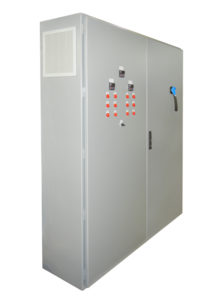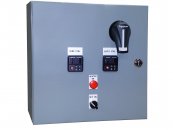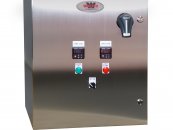What Are The Different Types of Control Panels?
Last updated on July 9th, 2019 at 06:54 pm
The control panel is the brain of a heating system. It controls and regulates operations for optimal performance. To get the best results, you need to pair the right brain with the right system. This guide explains the different types of control panels and how they operate, to help you select the best control panel configuration.
 Basic Operation of a Control Panel
Basic Operation of a Control Panel
A control panel has two primary functions:
- 1. Maintain or control a set value
- 2. Control action
To maintain or control a set value, a digital control panel requires a variable or parameter at a set value. For instance, in freeze prevention, the value would be a temperature range that keeps the medium above freezing.
The required variables are:
- The actual input signal, or process value (PV): In the above example, the PV is the current temperature.
- Desired setpoint value (SP): The SP is the target temperature.
The control panel uses these values to determine when to engage or disengage the control action. The control action depends on the controller. For example, a motor controller would engage the motor, where a temperature controller engages an industrial heater.
Temperature Controllers
 Temperature controllers are tasked with achieving or maintaining a set temperature. They are often paired with a heating system such as an immersion or circulation heater. The controller itself is one part of a larger control system which also includes:
Temperature controllers are tasked with achieving or maintaining a set temperature. They are often paired with a heating system such as an immersion or circulation heater. The controller itself is one part of a larger control system which also includes:
- An input sensor (such as a mechanical thermostat)
- A type of output signal
- A control algorithm
Using the input sensor, the digital controller is able to monitor the temperature of the target medium. This allows it to maintain a set temperature range.
If the temperature falls below the range, the thermostat alerts the controller, which engage the control action – turning on the heater. Once it reaches the target temperature, it signals the controller to disengage.
Most temperature control panels perform calculations involving temperature fluctuations and rates. This improves accuracy and reliability.
Temperature Controller Applications
Temperature controllers are essential in a number of heating and cooling applications, such as:
- Boiler
- Furnace
- Hot Runner
- HVAC
- Laboratory Control
Motor Controllers
A motor controller is responsible for starting, stopping, and running motors. The digital controller receives supply voltages and provides signals to the motor drives. They allow for motor operation in a programmed manner.
Programmed operations go beyond simply turning the motor on or off. The motor control panel can also increase speed, torque, or reverse the rotational direction of the motor.
Automation makes digital control panels a valuable tool for industrial applications. Motor controllers allow industries to meet the demands of the operating system and match installation requirements. As well, they are able to increase motor efficiency to better streamline operations and profits.
Motor Controller Applications
Motor controllers are application-specific devices. Some of their uses include:
- Multi-axis controllers
- Robotic motion controllers
- Servo amplifiers
- Convert AC power inputs to DC outputs (Inverter drivers)
- High-frequency drives
- Regeneration drives
- Support speed control and adjustment (Variable speed drives)
- Silicon controlled rectifiers (SCR)
Basic Types of Controllers: Electronic & Electromechanical
Electronic Controllers
Electronic controllers use an electrical signal to control actions. They can also be programmed to respond to system inputs and setpoint values. Electric controller units can include features like soft starting and variable frequency drives.
Electromechanical Controllers
An electromechanical controller uses electromagnetic contactors or relays. These allow them to stop, start, and reverse a motor’s direction.
Types of Temperature Controllers
 Temperature controllers are classified by the type of control they provide, and the type of device they control.
Temperature controllers are classified by the type of control they provide, and the type of device they control.
Limit “Setpoint” Controllers
A limit controller offers basic “On-Off” controls. It turns the heater on and then turns it off once it achieves the SP temperature. For many processes, this is sufficient. Especially where the environment is controlled.
Proportional Controllers
Proportional controllers are more complex. They don’t use a thermostat with an obvious setpoint. Instead, they use an effector device to measure the temperature in proportion to the environmental temperature. This allows them to adjust when equilibrium temperature changes.
Proportional, Integral, Derivative (PID) Controllers
PID Controllers are frequently used in industrial controller systems. They have a continual feedback loop allowing the device to constantly monitor and modulate for a greater degree of accuracy. They continuously calculate the margin between the PV and the SP and adjust the output accordingly.
Engineering Standards & Safety Considerations
Chief Applicable Standards
The International standards and directives for electrical equipment are continually changing. There are various standards for the construction of control panels depending on the region. But the general purpose is to ensure manufacturers provide control panels with attention to electrical safety.
Safety Considerations
Different working conditions and environments present a variety of safety considerations. Digital control panel construction customization is available to address a variety of potential hazards.
For example, explosion-proof temperature control panels are common for industries like chemical processing and mining. The design of explosion-proof control panels prevents a spark from occurring where volatile liquids or gases are present.
Wattco Control Panels
Wattco custom manufactures control panels and industrial heating systems. Get in touch with our team to help determine the right control panel type and configuration to streamline your operations. Contact a Wattco representative today.
